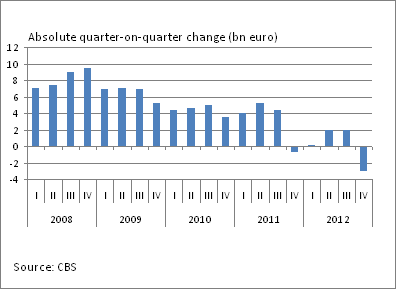Disposable household income dramatically down

In the fourth quarter of last year, the real disposable income of Dutch households was 3.2 percent down from one year previously. The decline is unprecedented since Statistics Netherlands started registration. Household consumption also declined further in the fourth quarter and the overall mortgage debt was reduced.
Price increase exceeds wage increase
The household income fell for the sixth consecutive quarter. Two factors play an important part in this respect, i.e. wages increased less rapidly than prices and the growing number of unemployed. The wage sum of all employees rose marginally by 0.2 percent in the fourth quarter. At the same time, consumer prices rose by an average of 2.3 percent. The disposable income declined in the fourth quarter, even if price corrections are not taken into account; by 0.9 percent relative to one year previously. The negative growth of the disposable income is caused by the fact that tax paid on income and property and social contributions were 2.2 percent up from one year ago. Social benefits, e.g. unemployment benefits, on the other hand, were 1.0 percent higher.
Real disposable income and household consumption

Income falls faster than consumption
Dutch consumers have less money to spend and this is reflected in consumption, although consumption fell less rapidly than income. In the fourth quarter, real consumption declined by 2.5 percent relative to the same period in 2011. The contraction in the fourth quarter was above the level of the preceding quarters. Since the onset of the credit crunch, consumption declined more only in the second quarter of 2009.
Mortgage debt stable
The mortgage debt of Dutch households was reduced by 3 billion euros in the fourth quarter of 2012 to 671 billion euros. On balance, this means that more mortgage loans were paid off than taken out. This development is also reflected in the situation on the housing market. The number of existing residential property units bought in the fourth quarter of 2012 slumped by more than 11.3 percent to nearly 36 thousand. Average prices of existing owner-occupied property were 7.4 percent down from the same period in 2011. House prices started to fall early 2009 and are still falling.
